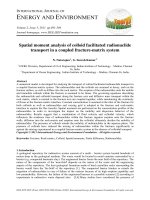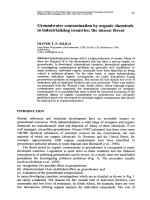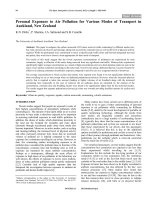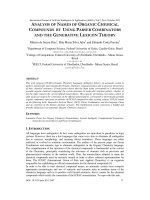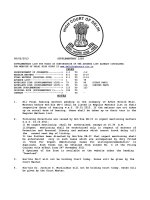- Trang chủ >>
- Khoa Học Tự Nhiên >>
- Vật lý
transport in multilayered nanostructures. the dynamical mean-field theory approach, 2006, p.343
Bạn đang xem bản rút gọn của tài liệu. Xem và tải ngay bản đầy đủ của tài liệu tại đây (18.89 MB, 343 trang )
james k freericks
Imperial College Press
transport in
multi layered
nanostructures
the dynamical mean-field
theory approach
transport in
multilayered
nanostructures
the dynamical mean-field
theory approach
James K Freericks
Georgetown University, USA
ICP
Imperial College Press
Published by
Imperial College Press
57 Shelton Street
Covent Garden
London WC2H 9HE
Distributed by
World Scientific Publishing Co. Pte. Ltd.
5 Toh Tuck Link, Singapore 596224
USA office: 27 Warren Street, Suite 401-402, Hackensack, NJ 07601
UK office: 57 Shelton Street, Covent Garden, London WC2H 9HE
British Library Cataloguing-in-Publication Data
A catalogue record for this book is available from the British Library.
TRANSPORT IN MULTILAYERED NANOSTRUCTURES
The Dynamical Mean-Field Theory Approach
Copyright © 2006 by Imperial College Press
All rights reserved. This book, or parts thereof, may not be reproduced in any form or by any means,
electronic or mechanical, including photocopying, recording or any information storage and retrieval
system now known or to be invented, without written permission from the Publisher.
For photocopying of material in this volume, please pay a copying fee through the Copyright
Clearance Center, Inc., 222 Rosewood Drive, Danvers, MA 01923, USA. In this case permission to
photocopy is not required from the publisher.
ISBN 1-86094-705-0
Printed by Fulsland Offset Printing (S) Pte Ltd, Singapore
For Susan, Carl, and Samuel
Preface
Multilayered nanostructures and thin films form the building blocks of most
of the devices employed in electronics, ranging from semiconductor transistors and laser heterostructures, to Josephson junctions and magnetic
tunnel junctions. Recently, there has been an interest in examining new
classes of these devices that employ strongly correlated electron materials, where the electron-electron interaction cannot be treated in an average
way. This text is designed to train graduate students, postdoctoral fellows, or researchers (who have mastered first-year graduate-level quantum
mechanics and undergraduate-level solid state physics) in how to solve inhomogeneous many-body-physics problems with the dynamical mean-field
approximation. The formalism is developed from an equation-of-motion
technique, and much attention is paid to discussing computational algorithms that solve the resulting nonlinear equations. The dynamical meanfield approximation assumes that the self-energy is local (although it can
vary from site to site due to the inhomogeneity), which becomes exact in
the limit of large spatial dimensions and is an accurate approximation for
three-dimensional systems. Dynamical mean-field theory was introduced
in 1989 and has revolutionized the many-body-physics community, solving a number of the classical problems of strong electron correlations, and
being employed in real materials calculations that do not yield to the density functional theory in the local density approximation or the generalized
gradient expansion.
This book starts with an introduction to devices, strongly correlated
electrons and multilayered nanostructures. Next the dynamical mean-field
theory is developed for bulk systems, including discussions of how to calculate the electronic Green's functions and the linear-response transport. This
is generalized to multilayered nanostructures with inhomogeneous dynam-
vii
viii
Transport in Multilayered Nanostructures:
The DMFT
Approach
ical mean-field theory in Chapter 3. Transport is analyzed in the context
of a generalized Thouless energy, which can be thought of as an energy
that is extracted from the resistance of a device, in Chapter 4. The theory
is applied to Josephson junctions in Chapter 5 and thermoelectric devices
in Chapter 6. Chapter 7 provides concluding remarks that briefly discuss
extensions to different types of devices (spintronics) and to the nonlinear
and nonequilibrium response. A set of thirty-seven problems is included
in the Appendix. Readers who can master the material in the Appendix
will have developed a set of tools that will enable them to contribute to
current research in the field. Indeed, it is the hope that this book will help
train people in the dynamical mean-field theory approach to multilayered
nanostructures.
The material in this text is suitable for a one-semester advanced graduate course. A subset of the material (most of Chapter 2 and 3) was taught
at Georgetown University in a one-half semester short course in the Fall of
2002. The class was composed of two graduate students, one postdoctoral
fellow, and one senior researcher. Within six months of completing the
course all participants published refereed journal articles based on extensions of material learned in the course. A full semester course should be
able to achieve similar results.
Finally, a comment on what is not in this book. Because many-body
physics is treated using exact methods that are evaluated numerically, we
do not include any perturbation theory or Feynman diagrams. Also there is
no proof of Wick's theorem, no derivation of the linked-cluster expansion,
and so on. Similarly, there is no treatment of path integrals, as all of
our formalism is developed from equations of motion. This choice has
been made to find a "path of least resistance" for preparing the reader to
contribute to research in dynamical mean-field theory.
J. K. Freericks
Washington, D.C.
May 2006
Acknowledgments
I have benefitted from collaborations with many talented individuals since
I started working in dynamical mean-field theory in 1992. I am indebted
to all of these remarkable scientists, as well as many colleagues who helped
shape the field with influential work. I cannot list everyone who played a
role here, but I would like to thank some individuals directly. First, I would
like to express gratitude to Leo Falicov who trained me in solid-state theory research and introduced me to the Falicov-Kimball model in 1989. His
scientific legacy continues to have an impact with many researchers. Second, I would like to thank my first postdoctoral adviser Doug Scalapino,
and my long-time collaborator Mark Jarrell, who prepared me for advanced
numerical work in dynamical mean-field theory, as we contributed to the
development of the field. Third, I want to thank Walter Metzner and
Dieter Vollhardt for inventing dynamical mean-field theory, Uwe Brandt
and his collaborators for solving the Falicov-Kimball model, and Michael
Potthoff and Wolfgang Nolting for developing the algorithm to solve inhomogeneous dynamical mean-field theory. Fourth, I would like to thank
my other collaborators and colleagues in dynamical mean-field theory and
multilayered nanostructures, including I. Aviani, R. Buhrman, R. Bulla,
A. Chattopadhyay, L. Chen, W. Chung, G. Czycholl, D. Demchenko, T.
Devereaux, J. Eckstein, A. Georges, M. Hettler, A. Hewson, J. Hirsch,
V. Janis, M. Jarrell, J. Jedrezejewski, B. Jones, A. Joura, T. Klapwijk,
G. Kotliar, R. Lemanski, E. Lieb, A. Liu, G. Mahan, J. Mannhart, P.
Miller, A. Millis, E. Muller-Hartmann, N. Newman, B. Nikolic, M. Ocko,
Th. Pruschke, J. Rowell, D. Scalapino, J. Serene, S. Shafraniuk, L. Sham,
A. Shvaika, A. N. Tahvildar-Zadeh, V. Turkowski, D. Ueltschi, G. Uhrig,
P. van Dongen, T. Van Duzer, M. Varela and V. Zlatic. I thank those
researchers who shared figures with me and granted me permission to pub-
ix
X
lish or republish them here. They include Sean Boocock, Nigel Browning,
Bob Buhrman, Ralf Bulla, Jim Eckstein, Antoine Georges, Claas Grenzebach, Alexander Joura, Gabriel Kotliar, Jochen Mannhart, Andrew Millis,
Nate Newman, Branislav Nikolic, Stephen Pennycook, Ilan Schnell, Serhii Shafraniuk, David Smith, Niki Tahvildar-Zadeh, Ted Van Duzer, Maria
Varela, Dieter Vollhardt, Joe Wong and Xia-Xing Xi. I also thank the funding agencies and program officers who have supported my research over the
years; this work received support from the National Science Foundation
under grant number DMR-0210717, the Office of Naval Research under
grants numbered N00014-99-1-0328 and N00014-05-1-0078, and supercomputer time was provided by the High Performance Computer Modernization
Program at the Arctic Region Supercomputer Center and the Mississippi
Engineering Research and Development Center. Finally, I thank my wife
and children who supported me through this project.
Contents
Preface
vii
Acknowledgments
1.
Introduction to Multilayered Nanostructures
1.1
1.2
1.3
1.4
1.5
2.
ix
Thin Film Growth and Multilayered Nanostructures . . .
Strongly Correlated Materials
The Proximity Effect
Electronic Charge Reconstruction at an Interface
Roadmap to Real-Materials Calculations
1
2
14
17
20
27
Dynamical Mean-Field Theory in the Bulk
31
2.1
2.2
2.3
2.4
2.5
31
39
46
53
2.6
2.7
2.8
2.9
2.10
3.
Models of Strongly Correlated Electrons
Second Quantization
Imaginary Time Green's Functions
Real Time Green's Functions
The Limit d — oo and the Mapping onto a
>
Time-Dependent Impurity Problem
Impurity Problem Solvers
Computational Algorithms
Linear-Response dc-Transport in the Bulk
Metal-Insulator Transitions within DMFT
Bulk Charge and Thermal Transport
Dynamical Mean-Field Theory of a Multilayered Nanostructure
3.1
61
67
77
80
92
99
113
Potthoff-Nolting Approach to Multilayered Nanostructures 113
xi
Transport in Multilayered Nanostructures: The DMFT Approach
3.2
3.3
3.4
3.5
3.6
3.7
3.8
3.9
Quantum Zipper Algorithm (Renormalized
Perturbation Expansion)
Computational Methods
Density of States for a Nanostructure
Longitudinal Charge Transport Through a
Nanostructure
Charge Reconstruction (Schottky Barriers)
Longitudinal Heat Transport Through a Nanostructure
Superconducting Leads and Josephson Junctions
Finite Dimensions and Vertex Corrections
Thouless Energy and Normal-State Transport
4.1
4.2
4.3
4.4
Heuristic Derivation of the Generalized Thouless
Energy
Thouless Energy in Metals
Thouless Energy in Insulators
Crossover from Tunneling to Incoherent Transport
in Devices
116
119
122
129
140
. 152
172
193
197
197
199
206
209
Josephson Junctions and Superconducting Transport
215
5.1
5.2
5.3
5.4
5.5
5.6
215
219
224
230
234
238
Introduction to Superconducting Electronics Devices . . .
Superconducting Proximity Effect
Josephson Current
Figure-of-Merit for a Josephson Junction
Effects of Temperature
Density of States and Andreev Bound States
Thermal Transport
6.1
6.2
Electronic Charge Reconstruction Near a
Metal-Insulator Transition
Thermal Transport Through a Barrier Near the
Metal-Insulator Transition
249
249
253
Future Directions
261
7.1
7.2
7.3
7.4
261
265
268
270
Spintronics Devices
Multiband Models for Real Materials
Nonequilibrium Properties
Summary
Contents
Appendix A
A.l
A.2
A.3
A.4
A.5
A.6
A.7
A.8
A.9
A. 10
A. 11
A.12
A. 13
A. 14
A. 15
A.16
A.17
A. 18
A. 19
A.20
A.21
A.22
A.23
A.24
A.25
A.26
Problems
Jellium model
Density of states for the hypercubic lattice in 1, 2, 3,
and oo dimensions
Noninteracting electron in a time-dependent potential . .
Relation between imaginary-time summations and
real-axis integrals
The Green's functions of a local Fermi liquid
Rigid-band approximation to the Falicov-Kimball model .
Comparing the spectral formula to the Hilbert transform
Imaginary-time Green's functions
Partition function for a spinless electron in a general
time-dependent field
Mapping the impurity in a field to an impurity
coupled to a chain in the NRG approach
Impurity Green's function for the chain Hamiltonian
in the NRG approach
Solving the NRG many-body Hamiltonian for the chain .
Metal-insulator transition in the half-filled
Falicov-Kimball model
Kramers-Kronig analysis for the Green's function,
and the effect of the pole in the Mott insulator
Metal-insulator transition on a simple cubic lattice . . . .
DC conductivity for the simple cubic lattice
Jonson-Mahan theorem
Charge and thermal conductivity for the FalicovKimball model
The particle-hole asymmetric metal-insulator transition .
Non Fermi-liquid behavior of the Falicov-Kimball model .
Thermopower of the Falicov-Kimball model and the
figure-of-merit
U -* oo Green's functions
Determining Ga/3 from the quantum zipper algorithm . .
The stability of the left and right recursion relations
of the quantum zipper algorithm
Efficient numerical evaluation of integrals via
changes of variables
Equilibrium solutions with charge reconstruction
xiii
271
271
272
273
274
276
276
278
278
279
279
281
282
283
283
284
287
288
290
291
291
292
292
293
294
294
296
xiv
Transport in Multilayered Nanostructures:
The DMFT
Approach
A.27 Local charge and heat current operators for a
nanostructure
297
A.28 Operator identity for the Jonson-Mahan theorem
299
A.29 BCS gap equation
299
A.30 Equations of motion needed for the Nambu-Gor'kov
formalism
300
A.31 Spin one-half atom in a time-dependent normal
and anomalous dynamical mean field
300
A.32 Hilbert transformation in the Nambu-Gor'kov formalism . 301
A. 33 Evaluating Hilbert transformation-like integrals needed
for determining the bulk critical current on a
simple-cubic lattice
302
A.34 The single-plane Mott-insulating barrier
304
A.35 Green's functions of the particle-hole symmetric
Falicov-Kimball model nanostructure
305
A.36 Parallel implementation for the resistance calculation
of a nanostructure
306
A. 37 Resistance and Thouless energy of a nanostructure . . . . 306
Bibliography
309
Index
323
Chapter 1
Introduction to Multilayered
Nanostructures
On December 29, 1959, Richard Feynman addressed physicists at the banquet of the annual meeting of the American Physical Society. The title
of his talk was "There's plenty of room at the bottom" [Feynman (1961)].
There was much conjecture amongst the audience as to what a talk with
that title would be about, but Feynman kept it secret. When he delivered
his speech, Feynman described the new field of nanotechnology, although
he did not coin that term. He described how one could write all of the
information published in all the books in the world on the head of a pin
using manipulation of atoms in three dimensions. At the time, the talk
seemed to be more science fiction than fact (see Chapter 4 of [Regis (1995)]
for a historical account), even though the scientific press published many
articles about the presentation; the field of nanoscience has only blossomed
since the early 1990s and now there are many devices that work with or
manipulate the properties of individual atoms, molecules, or small groups
of atoms or molecules.
The semiconductor industry has been reducing the size of structures in
its microprocessors at a rapid rate; they now create line features and transistors that are smaller than 100 nm. Current research on quantum dots treat
quantum-mechanical boxes that contain a few hundred to a few thousand
electrons in a small spatial region. Fabrication techniques have become so
sophisticated that novel devices can be made that involve the transport of
current through single molecules trapped between metallic electrodes. The
discovery of conducting carbon nanotubes has provided the nano world with
a possible electrical wiring system. It is clear that the future will hold many
surprises and technological advancements coming from nanotechnology.
As device features are made smaller and smaller, in particular, as they
become on the order of a few atoms (or nanometers) in size, quantum1
2
Transport in Multilayered Nanostructures:
The DMFT
Approach
mechanical effects begin to take over, and ultimately determine the device performance. It is the job of theorists to understand how to explain,
model, and design devices when quantum-mechanical effects cannot be ignored. In this book we discuss one particular kind of nanotechnology—the
field of multilayered nanostructures, which are composed of stacked atomic
planes of different materials, with the thickness of some of the layers in the
nanometer regime. Usually these devices are operated by attaching them
to a voltage (or current) source, which transports electrical or heat current
perpendicular to the stacked planes.
The approach and focus of this book are different from those of others. Most work on nanostructures focuses on devices that are small in all
(or all but one) dimensions, so it is appropriate to start from an atomic
or molecular picture and build up to the nanoscale devices (like quantum
dots or wires). This class of nanoscale devices usually have strong surface
effects, because the surface-to-volume ratio is usually large. Here we take
an alternative "top-down" approach as opposed to the more traditional
"bottom-up" approach, and consider systems in the thermodynamic limit
that have only one dimension on the nanoscale (more precisely only one
dimension has nanoscale inhomogeneity). This allows us to employ dynamical mean-field theory to solve the many-body problem because this
technique is accurate when the number of nearest neighbors for each lattice site is large. In a multilayered nanostructure, there are no surfaces, so
every lattice site maintains approximately the same number of neighbors
as in the bulk. Furthermore, multilayered nanostructures are already being
employed in technology, and are easier to manufacture and to use in devices
than systems that are nanoscopic in all dimensions. Hence, it is likely that
most applications that are commercially viable will involve multilayered
nanostructures (at least for the not-too-distant future). Indeed, this is the
motivation for producing this work.
1.1
Thin Film Growth and Multilayered Nanostructures
Multilayered nanostructures are the most common electronics devices that
have at least one length scale in the nano realm. They have been in use
for over five decades! The original devices are based mainly on semiconductors and the so-called pn junction. But research has been performed on
superconducting variants for over four decades, and there are commercial
devices in use for niche markets.
Introduction
to Multilayered
Nanostructures
3
Electronics devices often rely on nonlinearities to function. Either it
is the nonlinear current-voltage relation that determines the functionality
of the device (like in a pn junction where current flows in essentially one
direction), or it is the avalanche breakdown, or other nonlinear behavior,
that ultimately determines when the device ceases to work. The classic
multilayered nanostructure is a tunnel junction, consisting of a sandwich
of two metallic electrodes separated by a thin layer of insulator. They can
be easy to manufacture if the insulator is formed by exposing the metal
surface to air (or other oxygen containing gas mixtures like oxygen and
argon) where a native oxide layer will form. Since the two metallic regions
are connected by a "weak link" due to the proximity or tunneling effect
(described in Section 1.3), the connection is inherently due to quantummechanical effects and the uncertainty principle: electrons in the metal
cannot remain localized within the metal, but can leak through the barrier
into the other metal. If the electrodes are superconducting and the barrier
is thin enough, then the device is a Josephson junction.
A quantum-mechanical wavefunction is highly nonlinear. In classically
allowed regions, it will oscillate and have nodes, while in classically forbidden regions, it will exponentially decay. Both behaviors are nonlinear, and
ultimately lead to the nonlinear behavior of multilayered nanostructures.
We will not discuss nonlinearities much in this work, but we mention this
fact to remind the reader that whenever quantum-mechanical behavior governs the transport through a device, it is likely to have some underlying
nonlinear features. Tuning and controlling these nonlinear features is often
necessary to make the device useful. Examples of nonlinear current-voltage
characteristics in Josephson junctions are shown in Fig. 1.1.
Another useful feature in devices is controllability. Many semiconductor devices have a voltage gate which can be varied to change the behavior
of the device. Strongly correlated materials (described in Section 1.2) often have properties that can be sharply tuned by external fields, pressure
or chemical doping, and provide an interesting alternative of materials to
use in devices from the conventional metals, semiconductors, and insulators currently in use. They are of particular interest when one considers
controlling the transport of the spin of the electron (so-called spintronics
devices), since magnetism is inherently quantum mechanical in nature, and
many strongly correlated systems also display interesting magnetic properties. But, due to their quantum-mechanical behavior, involving correlated
motion of electrons, they are less well understood than semiconductors,
and fewer devices have been made from them. At the moment they hold
4
Transport in Multilayered Nanostructures:
a
The DMFT
Approach
(a)
Superconductors
/
1
Substrate
Fig. 1.1 Current-voltage curve for (a) a hysteretic Josephson junction and (b) a nonhysteretic Josephson junction. The bottom figure is a schematic of a Josephson junction
which corresponds to a superconductor-barrier-superconductor sandwich; the superconductor "leaks" through the barrier from one superconductor to the other carrying current
with a nonlinear current-voltage relation. The Josephson junction can carry current at
zero voltage up to the critical current Ic, and then it moves into a resistive state. If the
current-voltage curve is multivalued (left panel), then it is a hysteretic junction, while a
single-valued curve (right panel) corresponds to a nonhysteretic junction. Both curves
ultimately join up to the linear curve of Ohm's law (/ = V/Rn) at high voltage (Rn is
the normal-state resistance). The characteristic voltage where the current-voltage curve
starts to become linear is Vc ~ IcRn which is typically no larger than a few meV.
great promise and interest. This work hopes to aid with the design of novel
devices that use strongly correlated materials by enabling one to calculate
properties based on the underlying features of the materials that comprise
the device.
Modern science has made great strides in its ability to artificially grow
multilayered nanostructures. There are a number of different growth techniques that are used, and they each have their set of advantages and disadvantages. All growth processes start with a substrate material that is
chosen either for the lattice match with the candidate material to be grown
(to serve as a template and to relieve strain), for the chemical inertness
with respect to the growth material (to reduce interdiffusion and creation
of unwanted chemical species at the interface), or for practicality in sub-
Introduction
to Multilayered
Nanostructures
5
AIjO,
Fig. 1.2 Transmission electron micrograph of a sputtered device for use in spintronics.
The TEM image allows us to see individual atomic planes, and is able to discern the
chemical composition of each layer. Figure reprinted with permission from [Wang, et at.
(2005)] (©2005 American Institute of Physics).
sequent device processing. The ultimate goal of material growth is to lay
down atomically flat planes of each desired material, one plane at a time,
and modify the constitution of the growth planes as desired to make the
device of interest. In reality, this is never fully achieved with any technique,
but in current state-of-the-art device growth, it is possible to achieve almost atomic flatness of the epitaxial growth planes, and in some cases the
interface regions can be nearly atomically flat with limited interdiffusion or
chemical reactions.
The simplest way to grow materials is via sputtering, which involves
bombarding a target with inert ions, forcing the target atoms to be expelled and shower onto the substrate where the thin film will be grown (the
word sputtering comes from the Greek verb sputare which means to spit).
Sputtering is a simple growth process because one need not worry about
the relative vapor pressures of the constituents, since the material grows
in a nonequilibrium fashion. It also grows with the same stoichiometry as
that of the target (essentially because the atoms that are emitted all come
from the surface of the target). Sputtering is generally not believed to be
able to grow atomically sharp interfaces, and it can be difficult to guarantee uniform coverage during the growth process; its main advantages are
6
Transport in Multilayered Nanostructures:
Atomic Layer-by-Layer
Molecular Beam
Epitaxy
The DMFT
Approach
photomullipliet
**»
quadrapole
mass
spvclrome!-:-!
• atomic absoiption
spectroscopy for feedback
control
• ozone oxidation
lOd'J
lock
• in-situ RHEED with
digital video
• We have control over the
source fluxes to better
than 1 % accuracy (AA.RHEEI»
PlusZn
^^^-650-700 0
Rote-20 s/ml
POj-lO6 T
R H E E D reveals
surface crystal
structure
Fig. 1.3 Schematic of a molecular beam epitaxy growth chamber. The MBE growth
takes place in ultra high vacuum. Different sources are introduced by opening shutters
that allow the heated material to evaporate into the chamber. Many different means to
characterize the sample during growth are possible. For example, RHEED oscillations
show when a monolayer of growth is completed. Figure adapted ivith permission from
[Eckstein and Bozovic (1995)].
that it grows stoichiometrically and it is fast, so impurities may not have
a chance to enter the device in high concentrations. It can achieve high
quality growth, as illustrated in a spintronics device grown via sputtering that has nearly atomically flat interfaces for a variety of magnetic and
nonmagnetic multilayers [Wang, et al. (2005)].
Molecular beam epitaxy (MBE) is arguably the most precise of the
growing techniques. An MBE machine has growth conditions controlled
to high precision. The growth chamber is inside an ultra high vacuum
(UHV) chamber that has a sample holder and a series of growth materials
inside separate furnaces; shutters in front of the furnaces open to allow the
evaporated vapors of the different materials into the chamber, which will
hit the sample and stick. A schematic of such a device is given in Fig. 1.3.
Introduction
to Multilayered
Nanostructures
7
RHEED images at
different points of the
super cell growth
LSMO
»
• if
iMBfM
1
LSMO
....;..;]
-600
-300
0
300
E field (kV/cm)
Fig. 1.4 (Top) RHEED oscillations during growth showing the completion of each monolayer. (Bottom) Left panel: schematic of the complex dielectric oxide formed from
CaTiC>3, B a T i 0 3 , and SrTiOs along with a TEM image; right panel: dielectric response of different devices. Figure adapted with permission from [Warusawithana, et
at. (2003)] (original figure © 2003 the American Physical Society) and [Warusawithana,
Chen, O'Keefe, Zuo, Weissman and Eckstein (unpublished)].
The growth process can be monitored by RHEED oscillations which repeat
as each atomic monolayer is placed down. The growth is usually slow, with
perhaps a few seconds for each atomic layer. An example of the growth
of an artificially engineered dielectric is given in Fig. 1.4. The top panel
8
Transport in Multilayered Nanostructures:
to Cryogenic pump
\ /
The DMFT
Approach
'"•>.,
Fig. 1.5 Schematic of a PLD system for growing MgB2- The magnesium and boron
targets (heated up by the UV laser pulse) are supplemented by a so-called Knudsen (or
effusion) cell which is an evaporator of a beam of magnesium to maintain high enough
Mg pressure for stoichiometric growth. A residual gas analyzer monitors the gases in
the chamber, where the growth takes place in vacuum. Figure reprinted with permission
from [Kim and Newman (unpublished)].
shows the RHEED oscillations, while the bottom left panel is a TEM of
the different layers (with a schematic of the device) and the bottom right
is an example of the dielectric response as a function of the applied field.
Pulsed laser deposition (PLD) is another high precision growth technique. It involves ablating materials targets with a high power UV laser
pulse, which creates a plume that is directed at the sample. The growth
proceeds in spurts, in this fashion, and can achieve nearly atomic flatness,
but it is not as common to monitor the layer-by-layer growth as in MBE.
It is, however, typically much faster than growth in an MBE system, and
has emerged as a popular choice for thin-film device growth in research
laboratories because of its speed combined with its innate ability to preserve the target's stoichiometry. An example of a PLD system is shown in
the schematic picture of Fig. 1.5. A trilayered TiNbN-Ta x N-TiNbN sample
grown with PLD is imaged with a TEM in Fig. 1.6.
Introduction
to Multilayered
Nanostructures
9
Fig. 1.6 TEM images of a trilayered TiNbN-Ta^N-TiNbN sample suitable for processing
into a Josephson junction. The sample was made with the PLD process. The left panel
has the widest field of view, which is blown up in the upper right and then lower right
images. Note that although the interfaces meander across the sample, the barrier width
is quite uniform throughout the growth process. Figure reprinted with permission from
[Yu, et al. (2006)].
Chemical vapor deposition (CVD) is a technique often used in industrial manufacturing. A series of different gaseous phases of materials are
directed toward the sample, where a chemical reaction takes place at the
surface, facilitating the growth. CVD is complicated by the need to find
the right precursor chemical gases for a given growth process. It can be
combined with other techniques, such as in the growth of MgB2 a recently
discovered 40 K conventional electron-phonon superconductor, which uses
a gaseous phase for the boron, but thermal evaporation of solid metal for
the magnesium.
A schematic of this hybrid physical chemical vapor deposition (HPCVD)
procedure is illustrated in the left panel of Fig. 1.7 and is the process used in
making high quality MgB 2 films [Zeng, et al. (2002)]. It shows the sample
substrate region in black, atop the red sample holder. The boron gaseous
precursor flows continuously past the sample, and Mg vapor is generated
around the sample by the heating of solid Mg. The quality of the films can
10
Transport in Multilayered
Nanostructures:
The DMFT
Approach
S c h e m a t i c View
H,. BjHa
Fig. 1.7 Left panel: schematic diagram of the hybrid physical chemical vapor deposition
process used to make ultra high quality MgB2 films. Right panel: cross-sectional TEM
image of the films showing a narrow interface region, where the sample quality is degraded (diagonal region about five atomic planes thick near center of figure). Right panel
reprinted with permission from [Xi (unpublished)]. Left panel reprinted with permission
from [Progrebnyakov et al. (2004)] ( © 2004 the American Physical Society).
be seen in the cross-sectional TEM image in the right panel, which shows
the substrate (SiC), the high quality atomically flat layers of MgB2, and a
thin interface region (about five atomic planes thick) where substrate steps
and dislocation defects are located and degrade the sample quality. These
films are such high quality because the degraded region is so thin.
There are many ways to characterize the quality of the final device that
has been grown. We have already shown a number of TEM images, which
can determine where the atoms sit, and thereby provides information on the
flatness of the interfaces, and of interdiffusion or chemical reactions at the
interfaces. But a TEM image is a destructive process, because one needs to
slice, polish, and thin the sample until it can be imaged. Furthermore, we
are often interested in understanding properties of the transport in a device,
and such information cannot be revealed by TEM measurements. Another
technique that is quite useful is called ballistic electron emission microscopy
or BEEM for short. This measurement is shown schematically in Fig. 1.8. A

